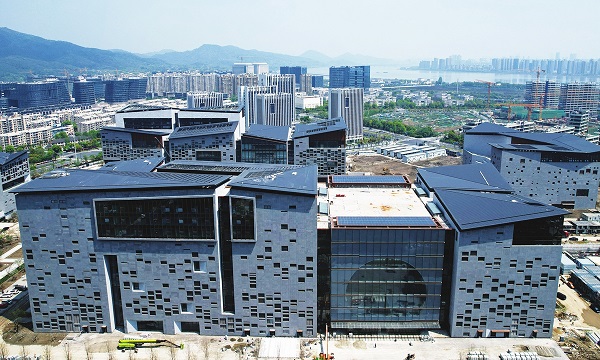Zhejiang Provincial Museum stores past of south of Yangtze River

A new wing of Zhejiang Provincial Museum in Hangzhou, East China's Zhejiang Province Photo: VCG
With an incredible history of 94 years, the Zhejiang Provincial Museum is one a the most important cultural institutions in Hangzhou, the province's capital city.
As one of the first public cultural institutions to be named by China's State Administration of Cultural Heritage as a "national first-class museum" in 2008, the Zhejiang Provincial Museum's strength dwells not only in its history but also the prolific archaeological resources south of the Yangtze River, a region traditionally known as Jiangnan.
The Neolithic Liangzhu culture, "a representation of ancient Jiangnan wisdom" is a "cultural fulcrum" of the museum, Xu Zikang, a Hangzhou-based historian, told the Global Times.
House of Liangzhu
The Zhejiang Provincial Museum has more than 100,000 relics in its collection. Among them, a jade cong, a tall rectangular ritual object used by the Liangzhu culture, is the museum's stellar item.
The jade piece is an 8.9-centimeter-long tube that has a rectangular outer section and a long circular hole running up its entire inner length. This design represents the later Chinese concept known as Nei Yuan, Wai Fang (lit: a circle inside and square outside), which cultural researcher Xu Shuming told the Global Times represents "discipline and harmony" and can be seen in many ancient Chinese artifacts and buildings.
The jade object is one of the most notable relics from the Neolithic Liangzhu culture, which dates back to 4,300 years to 5,300 years ago. The jade was engraved with a symbolic pattern commonly used by the culture that combining the features of animals and human beings.
Providing a virtual museum tour to the Global Times, the local historian said that other jade cong have been unearthed, yet the one at the Zhejiang Provincial Museum is the "king" as it is biggest and most finely crafted one found at the Liangzhu Site to date.
Located at the Yuhang district in Hangzhou, the Liangzhu Site has quite a few memorable features such as the world's earliest water conservancy system and evidence of ancient China's rice farming wisdom.
Xu told the Global Times that these features demonstrate the Jiangnan area's social landscape in ancient times, adding that when examining the "spiritual lives" of the Liangzhu people, the carved jade objects are a very important window.
The Zhejiang Provincial Museum has dedicated a special archive collection called Jiangnan Chen Xi (lit: Morning Light of Jiangnan) that focuses on Liangzhu's artifacts, especially those made from jade.
Another highlighted object there with the "king" cong is a "jade cap" that was once attached to the end of a scepter.
Xu told the Global Times that the relic was found along with the cong as a burial object. The delicate accessory reveals that the tomb owner's was probably a nobleman.
"As this piece shows, the Liangzhu people used jade not only for art, but also to define social positions," Xu added.
Rich resource
In 2019, the Liangzhu culture was listed as a UNESCO world cultural heritage site. It is also one of the major investigation sites for China's national project to trace the origins of Chinese civilization.
Wang Wei, the project's chief expert, told the Global Times that when looking at sites like the Liangzhu one needs to focus on the "spiritual connotations" of these relics and what they meant to ancient Chinese.
"We need a museum that preserves ancient people's humanistic spirit while also maintaining the geographical connection to where those people lived," cultural sociologist Chu Xin told the Global Times, adding that regional museums like the Zhejiang Provincial Museum maintain the site's "historical authenticity."
Besides the Liangzhu culture, the Zhejiang Provincial Museum also hosts relics from other ancient cultures, creating a cultural map of sorts to other archaeological spots in the province.
An ivory artifact adorned with birds believed to have been used in sun worship is a defining relic from the Hemudu culture, which dates back even further than the Liangzhu culture.
Discovered in Zhejiang Province's Ningbo, the Hemudu culture dates back to 7,000 year ago. Compare with the culture's commonly seen bamboo and wooden buildings, the ivory item is a rare exquisite artwork from the early stage of Chinese civilization.
Alongside the two main ruins, the Zhejiang Provincial Museum is filled with treasures from the province's Jiaxing-based Majiabang culture, the Huzhou-based Qianshanyang culture and the Jinhua-based Shangshan culture - all depicting Chinese civilization during the Neolithic period.
Covering an area of 20,400 square meters, the museum has a new 100,000-square-meter wing that is gearing up to embrace visitors in the latter half of 2023. The new hub focuses more on intangible cultural legacies and immersive cultural exhibitions.
"The archaeological resources in Zhejiang have made important contributions to the construction of the academic system and discourse system of Chinese archaeology and the development of global archaeology," Wang said.
-
Xi: Joint building of Belt and Road full of vitality
October 18, 2023
-
President Xi's remarks on the Belt and Road Initiative
October 16, 2023
-
Xi's Thought on Culture put forward
October 9, 2023
-
BRI 10 YEARS ON: Road to prosperity
October 16, 2023



